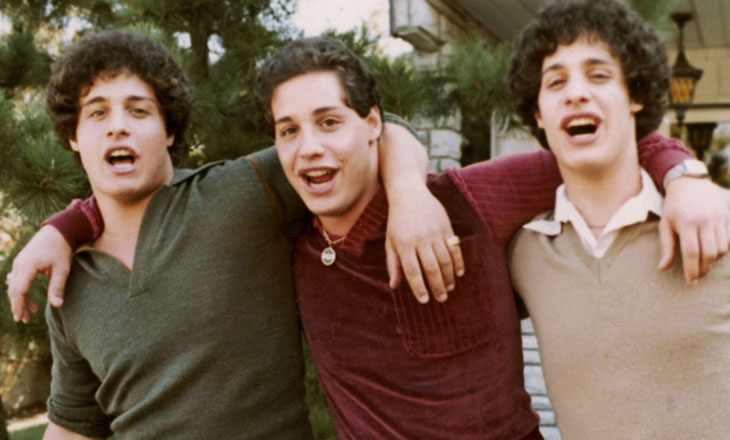I think I read in a David Mamet book one time that there are movies or plays that you see and think, “That was great… let’s grab some food.” Then there are movies and plays that stick with you long after they’re done.
Three Identical Strangers continues to stick with me since I saw it this past Monday.
Spoilers below. I suggest you go into this documentary knowing nothing about it except what you can glean from the title and the pictures associated with the movie.
Continue at your own risk.
You good?
Okay.
I always had this fantasy that I would have a long lost brother or twin. When I was a kid, it was because I thought it would be cool to have a best friend. As an adult, I thought about it from a different angle. How else might I have turned out given my genetic material? Would I be happier? Would I be more successful? Would I look the same? Maybe there’s a version of me who got way into weightlifting and tanning and also has a PhD. I’d just be interested to see how another version of me would turn out.
As it happens, I wasn’t the only one who thought that would be an interesting experiment.
The story starts with Robert Shafran telling the unbelievable story of his life. It’s the story you knew you were going to hear about discovering that he was a triplet wherein he finds that he had a long lost twin on Long Island named Eddy Galland.
After a few minutes, I found myself asking, okay, why are we only seeing Bobby right now? I knew that this story was supposed to be unbelievable beyond the premise of reunited triplets. Where are the other two? Is that what the twist is going to be? That the other two are in jail? Or maybe they’re in hiding somewhere because of the heist the three of them pulled off?
Then they introduce David Kellman, the third triplet, to tell his side of the story.
The question then becomes, okay, where’s Eddy?
The first half of the movie plays like act two of most biopics where the hero rises to fame complete with television appearances, partying at Studio 54, and a cameo in Desperately Seeking Susan (requested by Madonna herself).
But then the twist comes. These three were separated to be part of a psychological study of nature versus nurture. It was through the Louise Wise Adoption Agency, who would follow up with tests on these triplets in the home over a number of years.
The documentary features Lawrence Wright from the New Yorker (who also wrote Going Clear about Scientology and The Looming Tower about 9/11 among other books) who had done a lot of research while writing a piece on twins. They also interview two psychologists who participated in the study, one of whom actually tested the triplets.
After this, Robert and David delve deeper into their feelings of betrayal having been part of this study. Without the trauma of being separated at birth (as infants, they would bang their heads against the wall to fall asleep from separation anxiety), they might not have been troubled. When Eddy was put in an institution, David was able to help because he had been in an institution himself. All three admitted to troubled childhoods.
The documentary shows twin women who were part of this study (and had their fifteen minutes of nineties fame) and acknowledges that there are other sets of twins out there who may or may not know that they have a twin.
You spend time with these brothers and you get to like them. They’re New York guys from Long Island and Westchester. I just found myself hoping that their lives are okay. When David and Robert are on screen together, David says a quick, “good to see ya.” And I couldn’t tell if he was kidding around or if they hadn’t seen each other in a long time.
If they hadn’t, it would be understandable. Their restaurant caused a rift between Robert and his brothers and we find out why Eddy wasn’t interviewed. He took his own life in 1995.
Since seeing it my mind has been swimming in thoughts of nature vs. nurture and brotherhood and family and genes and mental illness and cruelty and ethics and, frankly, Nazis. Mengele experimented on twins. This experiment started in a time when lots of unethical tests were run on humans but the results of this study were never released. So, why was it done?
In a bit of a sadistic twist, the results have been sealed in a library at Yale until 2065 when it’s postulated that all subjects will be dead.
If you’ve read this far, I hope you’ve seen the documentary or will see it. It will make you think about how you were raised and how much control you really have over who you are.




